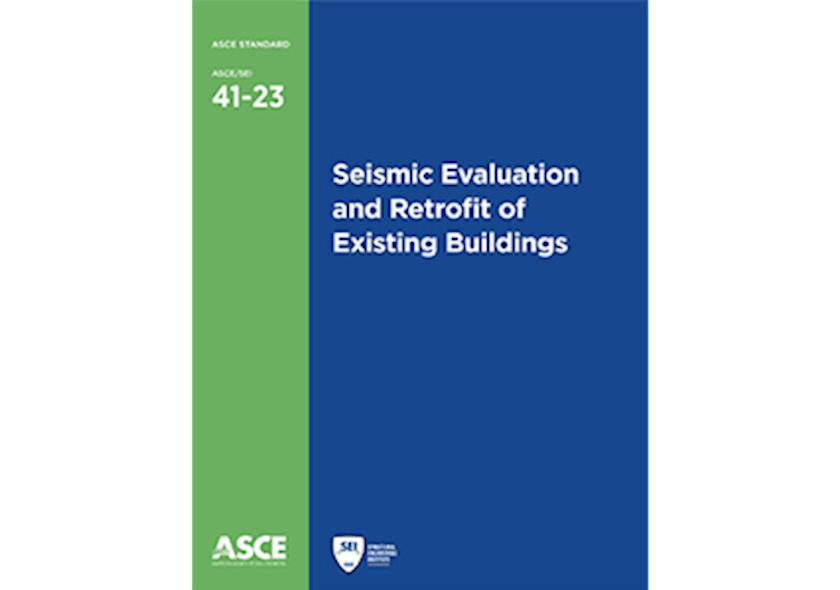Performance-Based Principles to Withstand Earthquakes: ASCE 41-23

Seismic Evaluation and Retrofit of Existing Buildings, ASCE/SEI 41-23
Rehabilitation methods used for existing buildings are different from those used in the design of new buildings. ASCE 41-23 uses performance-based principles to evaluate and retrofit existing buildings to withstand the effects of earthquakes. The standard presents a three-tiered process for seismic evaluation according to a range of building performance levels by connecting targeted structural performance and the performance of nonstructural components with seismic hazard levels.
The standard establishes analysis procedures and requirements for:
- Foundations and geologic site hazards;
- Components made of steel, concrete, masonry, wood, and cold-formed steel;
- Architectural, mechanical, and electrical components and systems; and
- Seismic isolation and energy dissipation systems.
One of the most reliable ways to ensure increased performance and resilience of our nation’s built environment is the widespread adoption and enforcement of up-to-date, modern building codes and standards.
Who develops standards?
ASCE’s volunteer technical committees work collaboratively to develop standards that advance the civil engineering industry. The Structural Engineering Institute of ASCE and specifically the Minimum Design Loads and Associated Criteria for Buildings and Other Structures Standards Committee work on ASCE 7. Standards development is generally on a five-year cycle to revise or reaffirm existing standards. Voting members represent a cross-section of the industry including producers, consumers, and regulatory entities.
ASCE is an ANSI-accredited standards development organization (SDO). ASCE Standards provide technical requirements or guidelines for promoting safety, reliability, productivity, and efficiency in civil engineering.
What is new in ASCE 41-23?
- Provisions to align with the multipoint response spectra in the new USGS seismic hazard model;
- Points to AISC 342 and ACI 369 for provisions related to structural steel and reinforced concrete existing buildings;
- Revisions to the nonlinear analysis provisions;
- Guidance to develop structural component modeling parameters and acceptance criteria; and
- Provisions for unreinforced and reinforced masonry.
Who develops standards?
ASCE’s volunteer technical committees work collaboratively to develop standards that advance the civil engineering industry. The Structural Engineering Institute of ASCE and specifically the Seismic Evaluation and Retrofit of Existing Buildings Committee work to update ASCE 41. Standards development is generally on a five-year cycle to revise or reaffirm existing standards. Voting members represent a cross-section of the industry including producers, consumers, and regulatory entities.
How does ASCE 41-23 help communities?
ASCE 41 provides guidance to ensure that existing buildings can be retrofitted to withstand seismic activity. This is particularly important in seismic prone areas, especially in the western United States and Alaska, to minimize loss of life and damage resulting from earthquakes. Communities and design professionals can apply this standard to reduce risk of collapse of older buildings during earthquakes and increase the safety of their occupants.
Who is using it?
ASCE 41-23 is a primary reference for structural engineers addressing the seismic resilience of existing buildings and for building code officials reviewing such work. Using this standard, engineers can focus on potential deficiencies deemed to be of concern for a specified set of building types and heights. Architects, construction managers, and academic researchers will also find this guidance beneficial. Jurisdictions and owners can require the standard as a way to ensure consistency in retrofit of portfolios of buildings and structures.
What is the Tier 1 Checklist?
In Standard 41-23, three tiers are established for seismic evaluation according to a range of building performance levels, where Tier 1 focuses on identifying potential deficiencies in existing buildings based on the performance of similar buildings in past earthquakes. The checklists (Tier 1 Checklists for Seismic Evaluation of Existing Buildings: Fillable Forms for Standard ASCE/SEI 41-17) are provided for a variety of building types and seismicity levels in support of the Tier 1 screening and are offered as fillable PDF forms that can be completed using Adobe Acrobat Reader, version 9.0 or later.
ASCE 41-23 is available in:
- Print (Soft Cover)
- E-book PDF
- Interactive digital access on the ASCE AMPLIFY platform
- Tier 1 Checklist

ASCE 41 and the ASCE Hazard Tool
The ASCE Hazard Tool allows users to look up key design parameters specified in ASCE standards. This free resource connects users to precise hazard data for eight environmental hazards including seismic, wind, tornado, ice, rain, flood, snow, and tsunami. Users can generate and download free PDF design reports to use in engineering proposals. Specific ASCE Hazard Tool references are included in the ASCE 41 text (and on ASCE AMPLIFY, our digital engineering publications platform).

